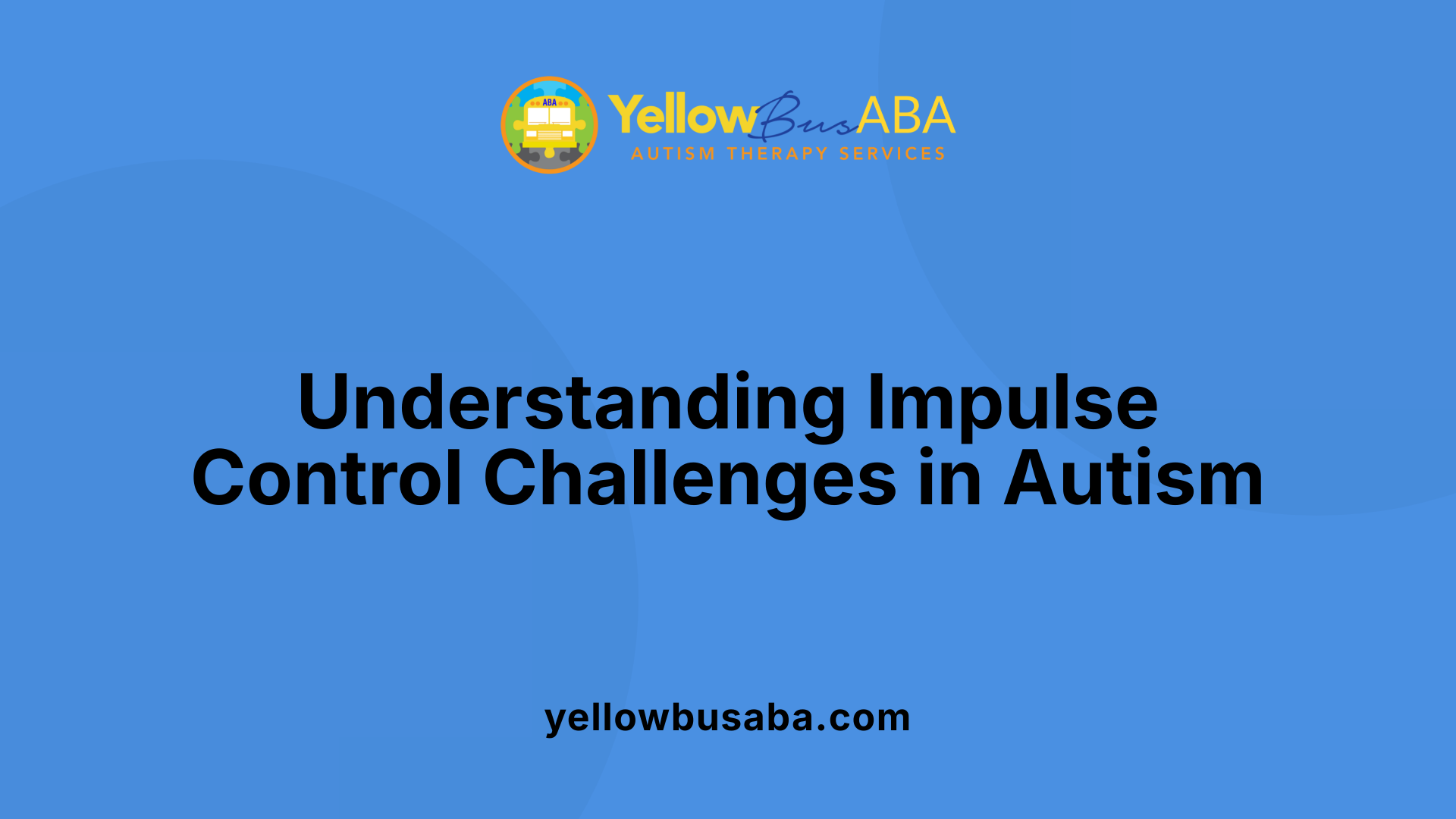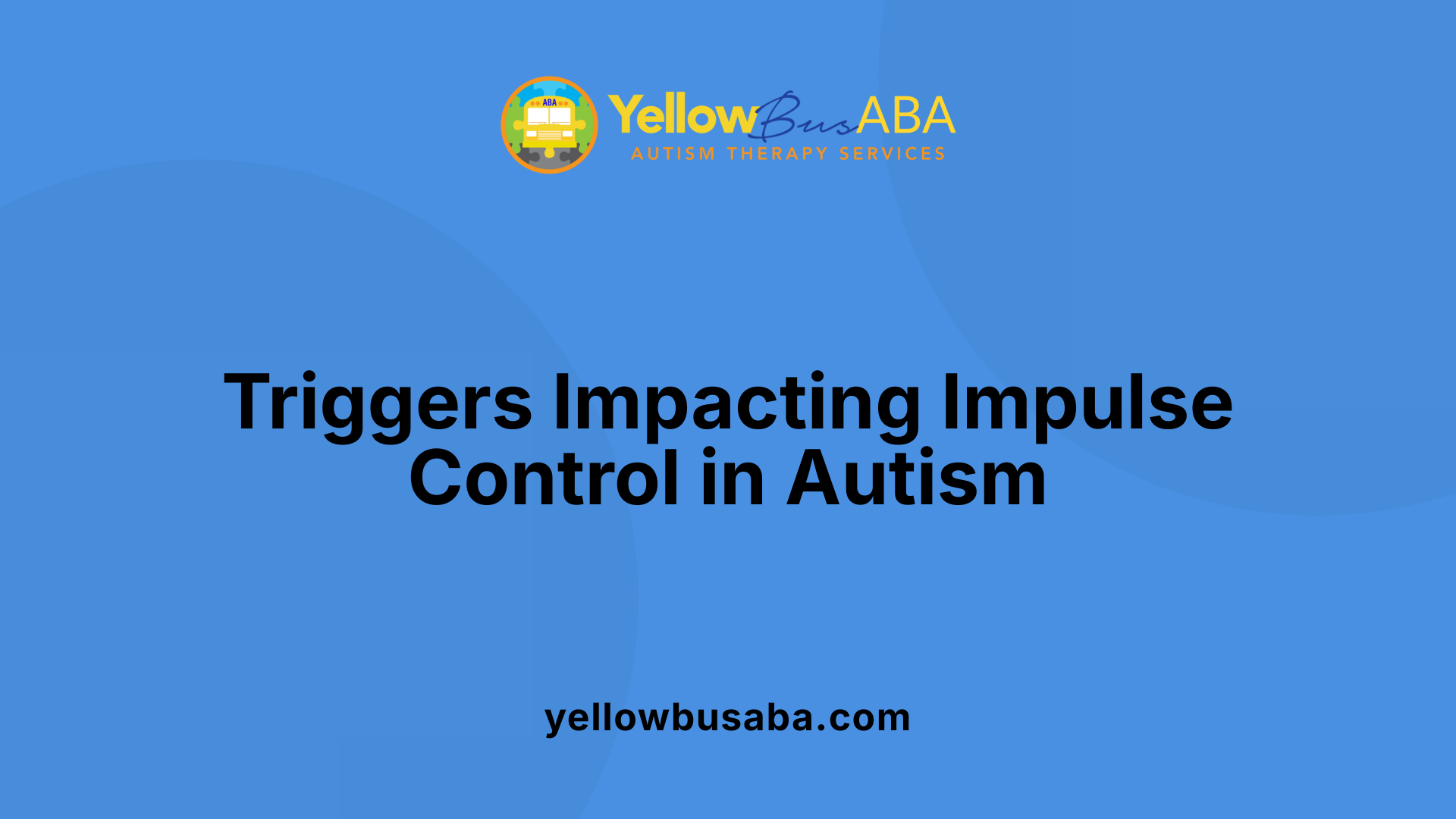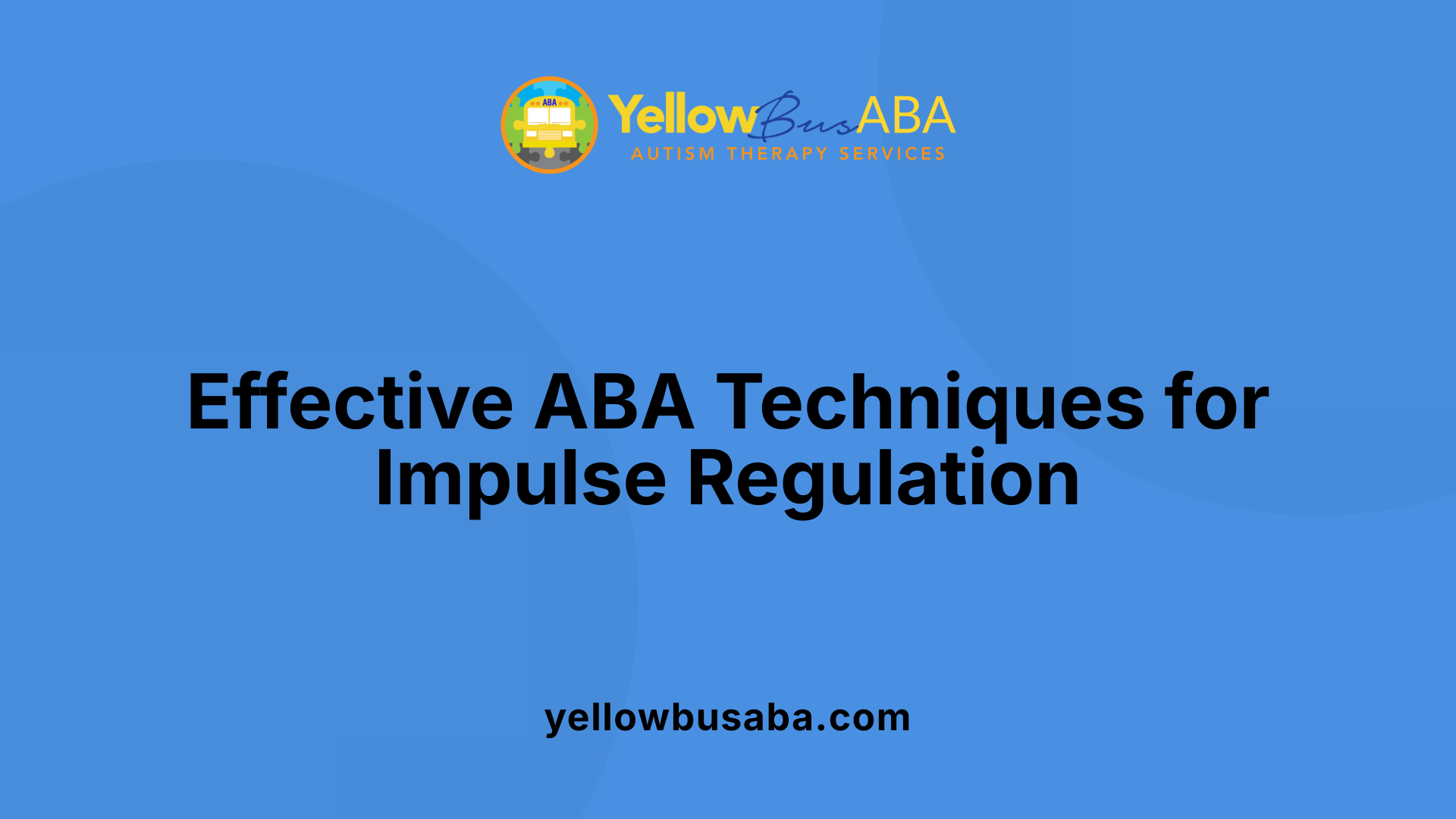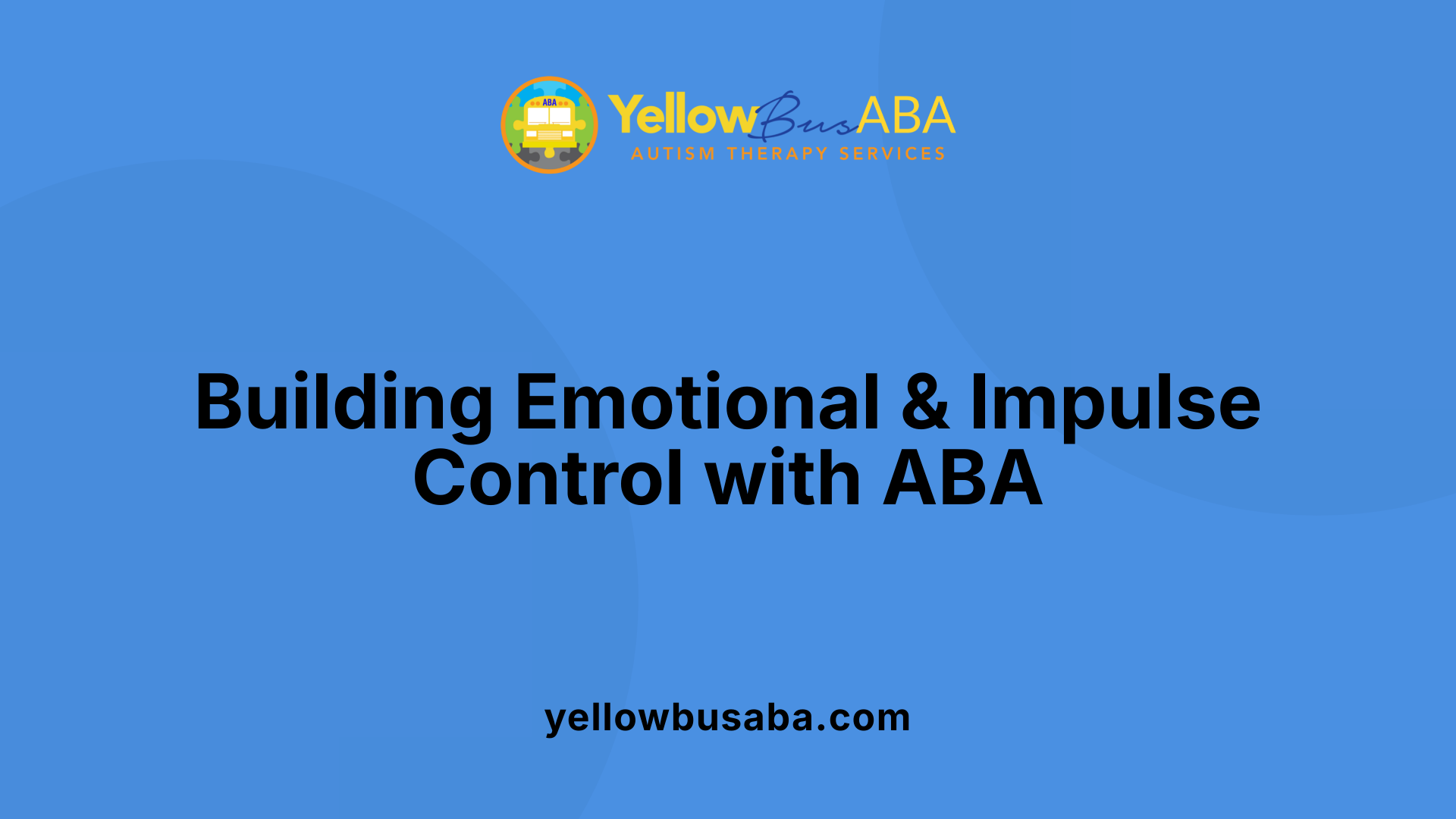How ABA Therapy Helps Children with Autism Manage Impulse Control
August 21, 2025
Empowering Children with Autism Through Behavioral Interventions

Understanding impulse control challenges in children with autism
Impulse control is a critical aspect of emotional and social development, yet many children with autism face significant difficulties in managing impulsive behaviors. These challenges stem from deficits in executive functioning—the brain's ability to plan, organize, and regulate responses—which are often characteristic of autism. Impulsivity can manifest as hyperactivity, emotional outbursts, or interruptive behaviors, affecting social relationships and safety. Recognizing and addressing these issues early can dramatically improve children's quality of life, and ABA therapy has emerged as a scientifically supported approach to developing better impulse regulation skills.
The Nature of Impulse Control Challenges in Autism

What is an overview of impulse control challenges faced by children with autism?
Children with autism often experience difficulties in controlling impulses due to underlying issues with executive functioning. Executive functions are mental processes that help us plan, organize, problem-solve, and regulate our behavior. When these skills are weaker or delayed, children may struggle with impulsivity.
Manifestations of impulse control issues in autism include hyperactivity, sudden emotional outbursts, yelling or striking, and interrupting conversations. These behaviors can interfere with learning, social relationships, and daily functioning.
Impulsivity not only affects how children interact but can also raise safety concerns, especially when impulsive actions lead to risky situations or accidents. These challenges are often linked to neurological differences in brain areas responsible for response inhibition and emotional regulation.
Several factors contribute to impulsivity in autism. Sensory overload from loud noises, bright lights, or certain textures can trigger impulsive reactions. Emotional regulation struggles, such as difficulty calming down after frustration, also play a role. Additionally, neurological differences in brain networks involved in impulse control can exacerbate these behaviors.
Support strategies are crucial. Visual schedules and social stories help children understand expectations and routines. Structured environments with predictable schedules reduce surprises that might provoke impulsive responses. Applied Behavioral Analysis (ABA) employs reinforcement and behavior management techniques to teach self-control and adaptive behaviors.
Addressing impulse control difficulties can lead to better behavioral management, improved emotional health, and enhanced social skills. Early intervention and tailored strategies are vital for helping children with autism develop the skills needed for better impulse regulation and a higher quality of life.
Common Triggers Affecting Impulse Control in Autism

What are common triggers that affect impulse control in children with autism?
Children with autism often face various situations and stimuli that can impact their ability to control impulses. One primary trigger is sensory overload. Bright lights, loud sounds, or unfamiliar environments can overwhelm their senses, leading them to react impulsively as a way to self-regulate or escape the situation.
Changes to routines also play a significant role. Disruptions to familiar schedules or unexpected environmental shifts can cause stress and frustration, often resulting in impulsive behaviors like outbursts or gestures of distress.
Communication difficulties are another important factor. Nonverbal children or those with speech delays may find it challenging to express their needs or frustrations verbally. As a result, they might resort to impulsive actions, such as grabbing, crying, or hitting, to communicate.
Furthermore, challenges related to executive functioning, such as difficulties with planning and delayed gratification, can impair impulse control. Children may struggle to wait for their turn or follow instructions, leading to impulsive responses.
Underlying neurobiological factors and comorbid conditions like ADHD, anxiety, or mood disorders can also intensify impulse control issues. These conditions influence the brain's ability to regulate behavior and emotions, making impulsivity more pronounced.
In summary, sensory sensitivities, environmental changes, communication barriers, executive functioning challenges, and additional neurodevelopmental conditions are common triggers that influence impulsive behaviors in children with autism. Understanding these triggers is essential to developing effective strategies to support impulse control and emotional regulation.
The Core Principles of ABA Therapy in Managing Impulsivity

How does ABA therapy support children with autism in managing impulsive behaviors?
Applied Behavior Analysis (ABA) therapy is a well-established approach used to help children with autism manage impulsive behaviors effectively. This therapy begins with a comprehensive assessment called Functional Behavior Analysis (FBA), which explores the specific triggers and motivations behind impulsive actions.
By analyzing the antecedents, behaviors, and consequences — known as the ABC model — behavior analysts can pinpoint what causes certain impulsive responses. This understanding allows for the design of personalized Behavior Intervention Plans (BIPs) that directly address the child's unique needs.
A central element of ABA therapy involves implementing reinforcement strategies. These strategies reward positive, adaptive behaviors and help reduce impulsive or aggressive responses. For example, children might learn to replace crying or striking with more acceptable ways of signaling needs, like using picture cards or words.
Structured activities, such as social skills training or role-playing, are incorporated to improve impulse control, patience, and communication. Teachers and caregivers are trained in consistent methods like neutral redirection — calmly guiding children back to appropriate behaviors without escalating the situation.
Behavior analysts play a vital role by continuously assessing progress and adjusting strategies to ensure meaningful improvements. They focus on fostering emotional regulation, enhancing decision-making skills, and increasing self-awareness.
Ultimately, ABA therapy helps children develop healthier responses to various triggers, resulting in fewer impulsive outbursts and better social integration. It aims for long-term growth by building skills that empower children to regulate their impulses and navigate daily life more successfully.
Effective ABA Techniques and Strategies for Impulse Regulation

What techniques and strategies are used in ABA therapy to improve impulse regulation?
Applied Behavior Analysis (ABA) utilizes a range of evidence-based methods to help individuals control impulsive behaviors effectively. Central to ABA are functional behavior assessments (FBA), which analyze the antecedents, behaviors, and consequences to understand why impulsivity occurs. This understanding allows therapists to design personalized Behavior Intervention Plans (BIPs) tailored to each individual's needs.
Reinforcement strategies are a cornerstone of ABA, particularly differential reinforcement. Techniques such as Differential Reinforcement of Alternative behaviors (DRA), Differential Reinforcement of Incompatible behaviors (DRI), and Differential Reinforcement of Other behaviors (DRO) are commonly employed.
- DRA encourages desirable behaviors as alternative responses to impulsivity.
- DRI reinforces behaviors that are incompatible with impulsiveness, preventing harmful outbursts.
- DRO focuses on increasing intervals without impulsive behaviors by rewarding the absence of such behaviors.
In addition to reinforcement, functional communication training is used to teach individuals appropriate ways to express needs or frustrations, reducing impulsive reactions driven by communication difficulties.
Teaching self-management skills is also vital. Strategies include task analysis, which breaks down complex tasks into manageable steps, and self-awareness exercises that help individuals recognize their triggers.
These combined approaches empower individuals with tools to anticipate and manage impulses proactively.
Benefits of ABA in Building Impulse Control and Emotional Regulation

What are the benefits of ABA therapy for impulse control in children with autism?
Applied Behavior Analysis (ABA) therapy provides numerous advantages for children with autism, especially in enhancing impulse control and emotional regulation. Through structured and personalized interventions, ABA helps children recognize their behaviors and learn to manage them more effectively.
One of the primary benefits is the use of positive reinforcement, which rewards desirable behaviors and discourages impulsive or inappropriate actions. This approach promotes self-regulation and encourages children to develop better control over their impulses in various settings.
ABA therapy typically involves breaking down complex behaviors into smaller, manageable steps. This method makes it easier for children to master skills needed for impulse control, such as waiting their turn, following instructions, and regulating emotions.
Another significant benefit is ongoing data collection and analysis. These practices allow therapists to monitor progress continuously and tailor strategies to meet each child's unique needs. Such personalized approaches increase the likelihood of achieving meaningful, long-lasting behavior change.
Over time, children experience improvements not only in reducing impulsive and disruptive behaviors but also in social interactions and independence. As a result, they can better navigate daily routines, build meaningful relationships, and participate more fully in academic and social activities.
Overall, ABA therapy plays a vital role in fostering emotional regulation, decision-making skills, and social competence. These improvements significantly enhance the quality of life for children with autism, providing them with the tools necessary for greater self-control and personal growth.
Addressing Impulsive Aggression and Related Behaviors with ABA

What is the role of ABA therapy in addressing impulsive aggression and related behaviors?
Applied Behavior Analysis (ABA) therapy plays a vital part in managing impulsive aggression among children with autism and other developmental challenges. It begins with a detailed assessment called a Functional Behavior Analysis (FBA), which helps identify the specific functions and triggers behind aggressive behaviors.
Once these triggers are understood, ABA employs targeted reinforcement strategies to encourage more appropriate responses. For example, caregivers and therapists are trained to use consistent techniques such as neutral redirection, where they calmly guide children away from aggressive actions toward more suitable ways of expressing needs.
Positive reinforcement is a cornerstone of ABA. Instead of rewarding aggressive acts, children learn to receive praise or tokens for demonstrating patience, calmness, or other acceptable behaviors. Skill-building in communication, emotional regulation, and self-control further supports reducing impulsivity.
Practitioners implement strategies like contingency management systems, including token economies—where children earn tokens for good behavior and trade them for rewarding activities. These approaches, combined with systematic changes to the environment, help diminish the frequency and intensity of impulsive outbursts.
Caregivers are empowered through training to ensure these techniques are applied consistently across different settings. When necessary, ABA therapy is complemented by medications and other therapies, forming a comprehensive, evidence-based method to improve behavioral outcomes.
In summary, ABA offers a structured, researched-based framework that addresses the root causes of impulsive aggression and provides practical tools to support emotional regulation, social skills, and self-control—improving daily life and social interactions for individuals with autism.
Integrating ABA into Broader Treatment Strategies for Autism and ADHD
 ABA therapy plays a significant role in comprehensive treatment plans for children with autism and ADHD, focusing on behavior regulation and skill development. It is frequently combined with other approaches such as medication, educational support, and social skills training to address various challenges holistically.
ABA therapy plays a significant role in comprehensive treatment plans for children with autism and ADHD, focusing on behavior regulation and skill development. It is frequently combined with other approaches such as medication, educational support, and social skills training to address various challenges holistically.
In practice, ABA techniques like positive reinforcement, structured routines, visual aids, and functional behavior assessments are tailored to each child's needs. These strategies help promote desirable behaviors, manage impulsivity, and facilitate learning in different environments, whether at home, school, or therapy settings.
Goal-setting and progress tracking are integral components of ABA, with active involvement from families. Caregivers and educators collaborate with therapists to set realistic targets, monitor improvements, and adjust interventions accordingly. This ongoing communication ensures that therapy remains responsive to the child's evolving needs.
Adapting ABA techniques to individual circumstances involves modifying activities to suit different settings and developmental levels. For example, for children with limited verbal skills, visual prompt systems or alternative communication methods may be integrated. Such flexibility helps maximize effectiveness and encourages generalization of skills across daily life situations.
Evidence indicates that, when properly implemented, ABA can lead to measurable improvements in behavior and impulse control. Children often exhibit increased self-regulation, better social interactions, and improved task completion.
Despite its demonstrated benefits, ongoing research continues to explore ways to enhance ABA's long-term impact. Incorporating quality of life metrics and broader developmental outcomes remains a focus, aiming to optimize treatment plans and ensure meaningful progress for children with autism and ADHD.
The Effectiveness and Long-Term Impact of ABA Therapy

How effective is ABA therapy in enhancing impulse control among children with autism and ADHD?
Research consistently shows that Applied Behavior Analysis (ABA) is a highly effective approach for improving impulse control in children with autism and ADHD. By using structured, evidence-based techniques such as positive reinforcement and functional communication training, ABA addresses the core reasons behind impulsive behaviors.
Customized to each child's needs, ABA programs focus on breaking down complex behaviors into manageable steps, modifying the environment, and teaching self-regulation skills. Strategies such as differential reinforcement reinforce desirable behaviors while reducing impulsivity. Task analysis and visual aids further support skill development and impulse management.
The role of consistent implementation cannot be overstated; trained therapists, parents, and educators working together ensure that interventions are reinforced across settings, strengthening gains over time. Regular progress monitoring allows for adjustments to keep strategies effective. As a result, children learn to better regulate emotions, improve social interactions, and participate more fully in daily activities.
Improvements in impulse control, social skills, and independence
ABA therapy leads to tangible improvements beyond impulse control, notably in social behavior and independence. Children become better at waiting their turn, following instructions, and managing emotions, which enhances peer relationships and classroom participation.
Social skills such as initiating conversations, sharing, and understanding social cues often improve as part of the therapy. Emotional regulation also benefits, reducing tantrums, aggression, and other maladaptive responses.
Furthermore, children develop greater independence in managing their behaviors and routines, promoting self-confidence and reducing reliance on caregivers.
Importance of consistency, training, and progress monitoring
Achieving long-term success with ABA depends heavily on consistent application across home and school environments. Caregivers and teachers are trained to use reinforcement, redirection, and visual supports to maintain progress.
Ongoing assessment by professionals ensures interventions stay aligned with the child's evolving needs. Data collection and analysis enable therapists to modify strategies, intensify focus on specific behaviors, and celebrate successes.
This continuous cycle of assessment and adaptation fosters sustained improvements in impulse control and overall functioning.
Success stories and case examples
Many children have experienced remarkable transformations through ABA therapy. For example, Aarav showed significant reduction in impulsive outbursts and improved social interactions after several months of structured intervention. Ria gained better emotional regulation and started participating confidently in group activities, while Karthik's ability to delay gratification improved, leading to enhanced academic performance.
These success stories highlight the effectiveness of tailored ABA strategies and the importance of early intervention, consistency, and professional guidance. They serve as inspiring evidence of how structured behavioral support can lead to meaningful, lasting change in children with autism and ADHD.
Empowering futures with behavioral science
In summary, ABA therapy stands as a cornerstone in supporting children with autism and ADHD to master impulse control. Through tailored interventions that analyze behaviors, understand triggers, and reinforce positive responses, ABA equips children with essential skills for social interaction, emotional regulation, and independence. Its evidence-based strategies—such as reinforcement, communication training, and structured routines—are backed by research and success stories, demonstrating significant long-term benefits. Integrating ABA within a holistic treatment plan, including medical and educational support, maximizes positive outcomes and empowers children to navigate their worlds more effectively. As behavioral science continues to evolve, so does the promise of a brighter, more controlled future for children with autism—making impulse management not just a goal, but an achievable reality.
References
- Autism and Impulse Control: What Caregivers Should Know
- ABA in the Treatment of Aggression and Impulse Control
- Autism and Impulsive Aggression: All You Need to Know
- Curbing Impulses: 7 Strategies for Teaching Impulse Control
- ABA Therapy for ADHD: Effective Strategies for Kids
- Transforming Lives with Impulse Control Therapy Technique for ...
- ABA Techniques to Reduce Impulsivity in Kids with ADHD - Five Steps
- Is ABA Therapy Worth It? - Behavioral Intervention For Autism
- ABA Therapy for ADHD: Effective Strategies for Kids
- ABA Therapy for ADHD Treatment - Manhattan Psychology Group






